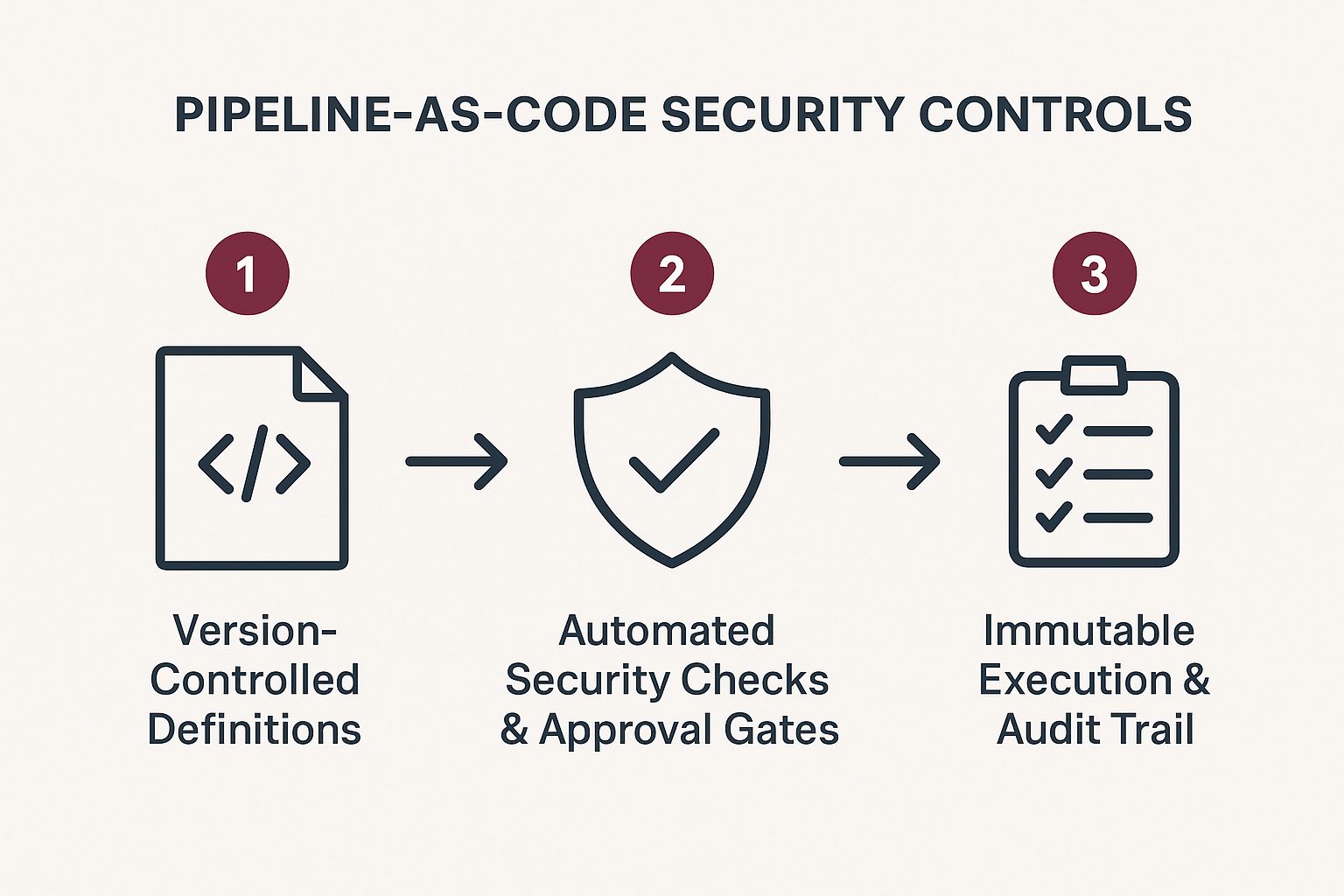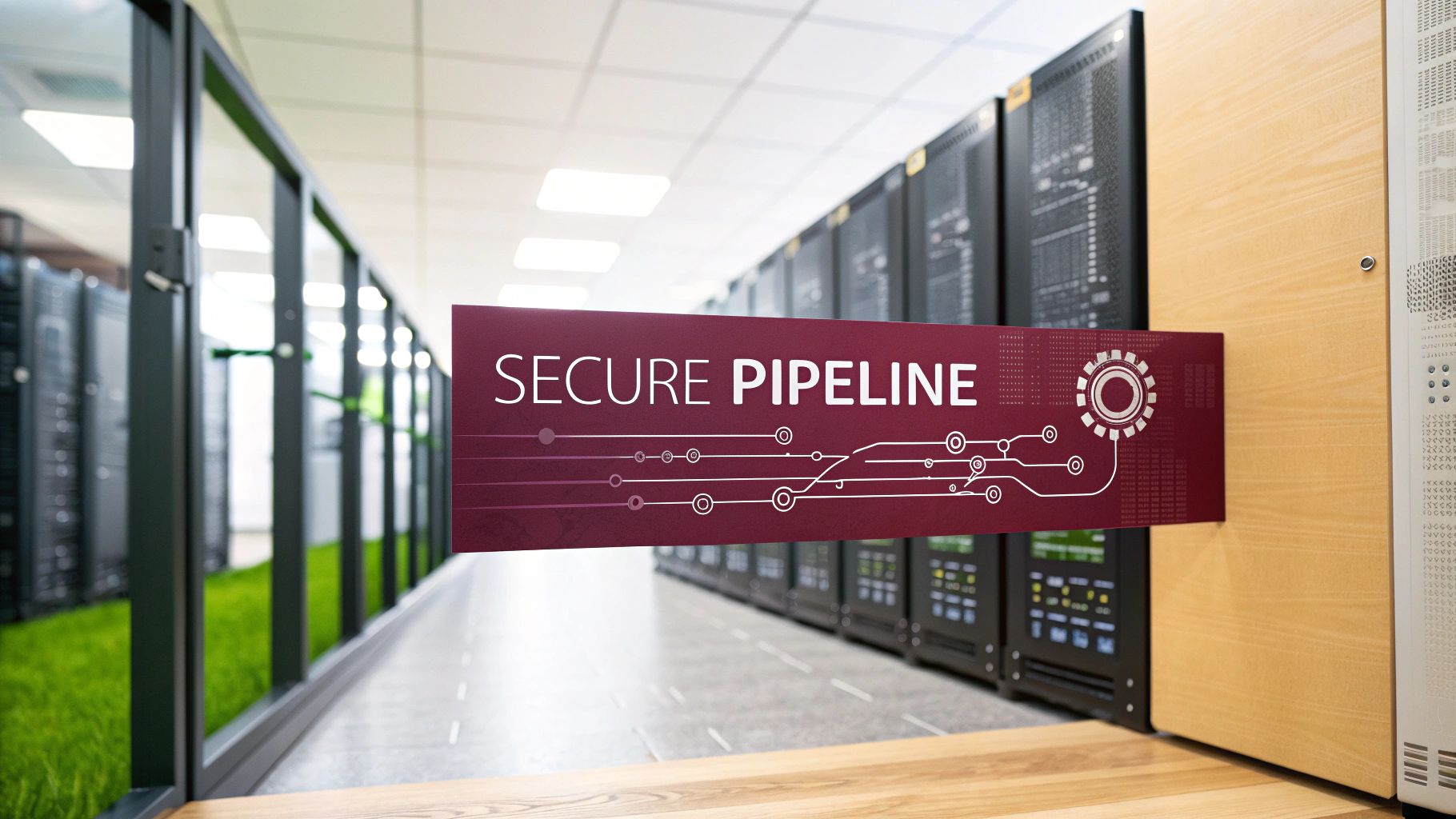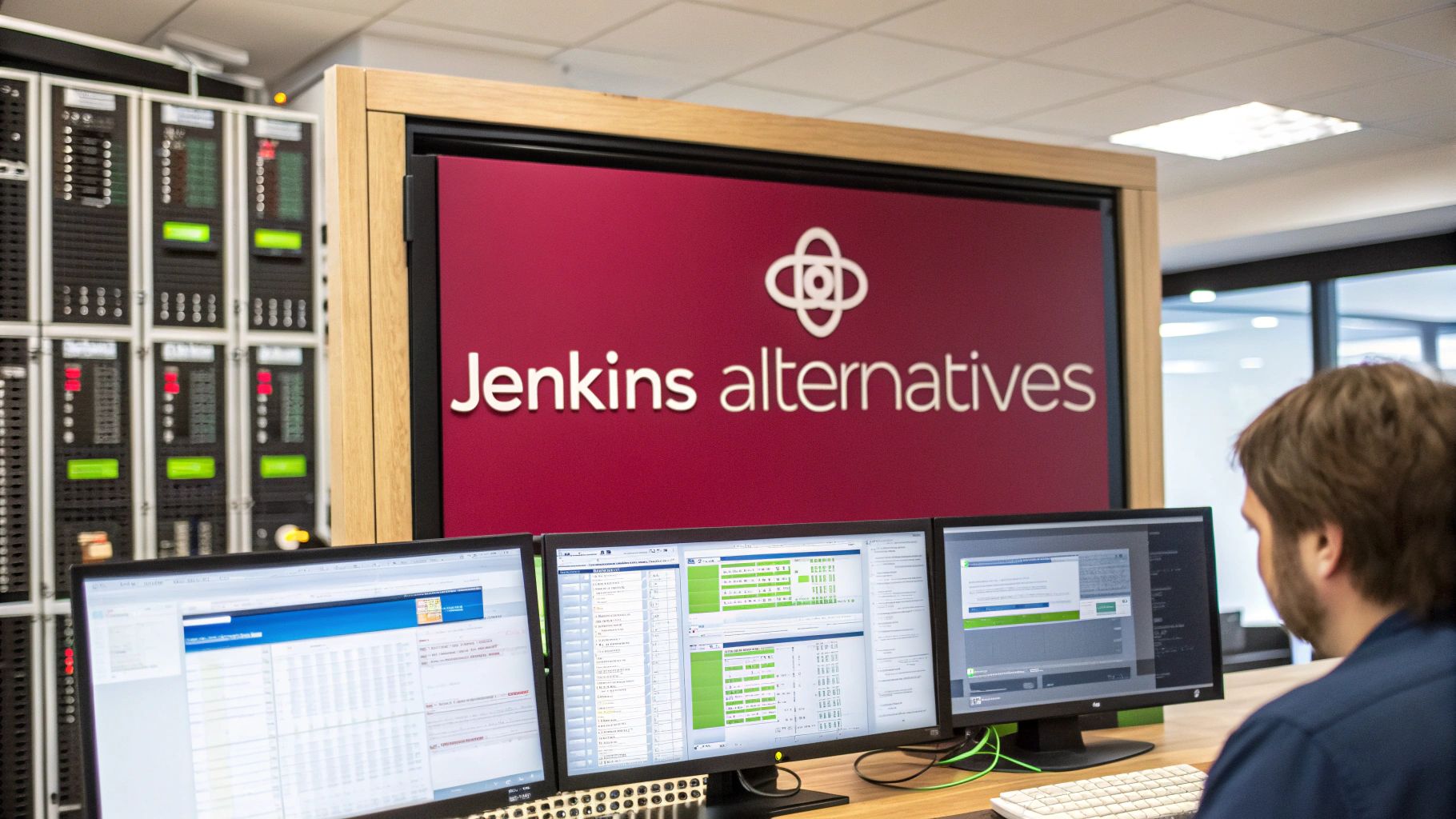Building a Secure CI/CD Pipeline in 2025
This article presents eight essential CI/CD security best practices for 2025. Learn how to build a secure software delivery pipeline and protect your applications. Implementing these CI/CD security best practices enables faster releases without compromising security. From secure secret management to pipeline monitoring, you’ll gain actionable strategies to mitigate risks and deliver secure software. This list covers key areas like Infrastructure as Code (IaC) security scanning, container image security, and least privilege access, giving you the tools to strengthen your pipeline.
1. Secure Secret Management
Secure secret management is a foundational pillar of secure CI/CD pipelines and a critical element of CI/CD security best practices. It involves the careful handling of sensitive information such as passwords, API keys, tokens, and certificates throughout the software development lifecycle. Instead of embedding these secrets directly into configuration files or source code—a practice that invites security vulnerabilities—secure secret management dictates the use of dedicated tools and strategies designed to protect, control, and manage access to these critical assets. This approach mitigates the risk of unauthorized access, accidental leaks, and malicious exploitation, ultimately ensuring the integrity and security of your applications and infrastructure.

Secret management solutions typically operate by encrypting sensitive credentials both at rest and in transit. They offer centralized secret storage with granular access controls, often integrating with identity management systems to enforce the principle of least privilege. Automated rotation of secrets is another key feature, limiting the impact of any potential compromise by regularly changing credentials. Comprehensive audit logging provides a detailed record of all secret access events, facilitating security analysis and incident response.
This approach is particularly valuable in CI/CD pipelines due to the automated nature of the process. By integrating secret management into your CI/CD workflow, you ensure that sensitive information is handled securely throughout the build, test, and deployment stages. This approach is essential for organizations of all sizes, from startups to enterprises, and particularly crucial for React Native app developers, DevOps and release engineers, QA and beta testers, and security-conscious organizations seeking real-time insights and enhanced protection.
Features of robust secret management systems include:
- Encryption of sensitive credentials at rest and in transit: Protecting secrets from unauthorized access even if storage or communication channels are compromised.
- Automated rotation of secrets and credentials: Regularly changing secrets reduces the impact of any potential breach.
- Centralized secret storage with access controls: Providing a single, secure repository for all sensitive information with strict access limitations.
- Integration with identity management systems: Leveraging existing identity platforms to streamline authentication and authorization.
- Audit logging for all secret access events: Maintaining a comprehensive record of who accessed what secrets and when.
Pros:
- Prevents unauthorized access to sensitive credentials
- Reduces risk of secret leakage in source code
- Simplifies credential rotation and management
- Provides comprehensive audit trails
- Enables fine-grained access control
Cons:
- Can add complexity to pipeline setup
- May introduce slight performance overhead
- Requires additional infrastructure to manage
- Teams need training on proper implementation
Examples of successful implementations include Netflix using HashiCorp Vault to manage secrets across its microservices architecture, Airbnb leveraging AWS Secrets Manager for secure database credential storage and rotation, and Microsoft’s internal development teams utilizing Azure Key Vault. These examples demonstrate the scalability and effectiveness of secret management solutions in diverse, real-world scenarios.
Actionable Tips:
- Never store secrets in source code repositories.
- Implement automatic secret rotation policies.
- Use environment variables for temporary secret access during build/deploy.
- Leverage identity-based access instead of long-lived tokens where possible.
- Implement monitoring to detect potential secret leaks or unauthorized access.
Popularized by industry leaders like HashiCorp (Vault), AWS (Secrets Manager), Google (Secret Manager), Microsoft (Azure Key Vault), and CyberArk, secure secret management has become an indispensable aspect of modern software development. Learn more about Secure Secret Management to understand its intricacies and best practices. By incorporating secure secret management into your CI/CD pipeline, you significantly enhance your organization’s security posture and protect valuable assets.
2. Infrastructure as Code (IaC) Security Scanning
One crucial CI/CD security best practice is Infrastructure as Code (IaC) Security Scanning. This process leverages automated tools to analyze your infrastructure definitions – written in languages like Terraform, CloudFormation, or Kubernetes manifests – for security misconfigurations, compliance violations, and potential vulnerabilities before they are deployed. This “shift-left” approach is invaluable in identifying and remediating security risks early in the development lifecycle, preventing them from reaching production environments. Implementing IaC security scanning as part of your CI/CD pipeline strengthens your overall security posture and contributes significantly to robust and reliable application delivery.
How It Works:
IaC security scanning tools typically use static analysis techniques to examine your infrastructure code. They compare your code against a set of predefined rules and policies, which can be based on industry best practices (e.g., CIS Benchmarks, NIST standards, PCI-DSS), or custom rules tailored to your organization’s specific security requirements. These tools integrate seamlessly into your CI/CD pipeline, allowing for automated security checks at various stages, such as pre-commit, pull request review, and pre-deployment.
Features and Benefits:
- Static analysis of infrastructure code: Analyzes code without actually deploying it, enabling early detection of vulnerabilities.
- Pre-commit and CI/CD pipeline integration: Automates security checks as part of your development workflow.
- Policy-as-code enforcement: Codifies your security policies and ensures consistent application across all infrastructure.
- Compliance validation against industry standards: Helps you meet regulatory requirements and adhere to established security best practices.
- Custom rule development capabilities: Allows you to create rules specific to your organization’s unique security needs.
Pros:
- Identifies security issues before infrastructure is deployed, saving time and resources.
- Reduces cloud misconfiguration risks, a leading cause of security breaches.
- Enforces organizational security policies consistently across all deployments.
- Provides immediate feedback to developers, fostering a security-conscious culture.
- Helps maintain compliance with regulatory requirements.
Cons:
- May produce false positives, requiring careful tuning and configuration.
- Requires regular updates to security rules to stay ahead of emerging threats.
- Can slow down pipeline execution if not optimized.
- May involve a learning curve for creating custom policies.
Examples of Successful Implementation:
- Capital One: Uses Terraform with automated security scanning to maintain compliant cloud infrastructure.
- Atlassian: Implements IaC scanning across their AWS deployments to ensure security and compliance.
- Spotify: Leverages automated IaC security checks to scale security effectively across hundreds of microservices.
Actionable Tips:
- Integrate IaC scanning into pre-commit hooks: Get early feedback and prevent security issues from entering the codebase.
- Establish baseline security policies for all infrastructure: Define minimum security requirements for all deployments.
- Start with blocking critical issues only, then gradually increase strictness: Avoid overwhelming developers with too many alerts initially.
- Create team-specific rule exceptions when necessary: Allow for flexibility while maintaining overall security standards.
- Maintain a central repository of approved, secure IaC modules: Promote code reuse and ensure consistent security across projects.
Why this is a CI/CD Security Best Practice:
In the fast-paced world of CI/CD, ensuring the security of your infrastructure is paramount. IaC security scanning addresses this need by automating security checks throughout the development pipeline. By catching vulnerabilities early and enforcing security policies consistently, this practice contributes significantly to building secure and reliable applications, making it an essential part of any robust CI/CD strategy. This is especially important for our target audience – from React Native developers leveraging cloud infrastructure to security-conscious enterprise organizations – who benefit from the proactive security measures provided by IaC scanning. Tools popularized by organizations like HashiCorp (Terraform), Bridgecrew (acquired by Palo Alto Networks), Snyk, Chef (InSpec), and AWS (CloudFormation Guard) make implementation more accessible than ever. By embracing IaC security scanning, organizations can strengthen their CI/CD pipelines and minimize the risk of security breaches caused by infrastructure misconfigurations.
3. Container Image Security Scanning
Container image security scanning is a crucial CI/CD security best practice that helps protect your applications from vulnerabilities. It’s the automated process of analyzing container images for security flaws, malware, and misconfigurations before they are deployed to production. This proactive approach significantly reduces the risk of deploying vulnerable containers and strengthens the overall security posture of your CI/CD pipeline. By identifying and addressing these issues early in the development lifecycle, you prevent potential exploits and maintain a more secure software supply chain.

This automated analysis typically involves several key features: vulnerability scanning of both operating system (OS) packages and application dependencies within the image; detection of embedded secrets (like API keys or passwords) and other sensitive data; image signing and verification to ensure image authenticity and integrity; configuration and compliance checks against security best practices and industry standards; detailed image layer analysis for granular vulnerability identification; and seamless integration with container registries for automated scanning upon image push or pull.
Container image security scanning offers several compelling advantages. It prevents the deployment of vulnerable containers, providing crucial visibility into the software supply chain by revealing the components and dependencies within each image. It enables automated policy enforcement, allowing you to define acceptable vulnerability thresholds and automatically block deployments that don’t meet these criteria. This automation significantly reduces the attack surface in production environments and supports compliance requirements for various security standards.
However, container image scanning also presents certain challenges. It can generate a high volume of findings, requiring prioritization based on severity and exploitability. It might also block deployments for non-critical vulnerabilities, potentially impacting release cycles. The varying detection capabilities of different image scanning tools require careful selection and configuration. Finally, integrating scanning into the CI/CD pipeline can introduce performance overhead, though the benefits often outweigh this impact.
Why this is a CI/CD Best Practice: Container image scanning is essential for securing modern application deployments because containers are often built from various sources and may contain unknown vulnerabilities. Integrating security scanning directly within the CI/CD pipeline shifts security left, enabling early detection and remediation before vulnerabilities reach production. This proactive approach aligns with DevOps principles by embedding security into every stage of the development lifecycle.
Examples of Successful Implementation:
- Google Cloud utilizes Binary Authorization to enforce policies that ensure only trusted container images are deployed to their production environments.
- PayPal implemented container image scanning across their extensive microservices architecture to enhance the security of their payment platform.
- Red Hat incorporates container scanning and signing within their OpenShift platform, providing a robust and secure container orchestration solution.
Actionable Tips:
- Use minimal base images: Start with a small and secure base image to minimize the attack surface and reduce the number of potential vulnerabilities.
- Implement a vulnerability severity threshold: Define an acceptable level of risk based on your organization’s security policies and risk tolerance. Configure your scanning tools to block deployments exceeding this threshold.
- Regularly update base images: Stay up-to-date with security patches by regularly updating base images to incorporate the latest fixes.
- Implement container signing: Digitally sign container images to verify their integrity and authenticity, preventing tampering and ensuring that only authorized images are deployed.
- Run containers with least privilege principles: Grant containers only the necessary permissions to minimize the impact of a potential compromise.
- Create a process for exception handling: Establish a clear process for handling situations where critical vulnerabilities cannot be immediately fixed, allowing for temporary exceptions while remediation efforts are underway.
Popularized By: Docker (Docker Security Scanning), Red Hat (Quay Security Scanner), Aqua Security, Sysdig, Snyk
This practice is particularly relevant to React Native app developers, DevOps and release engineers, QA and beta testing teams, security-conscious enterprise organizations, and product managers seeking real-time insights into the security posture of their applications. By integrating container image security scanning into your CI/CD pipeline, you proactively address vulnerabilities, reduce the attack surface, and ensure the delivery of secure and reliable applications.
4. Automated Security Testing in CI/CD Pipelines
Automated security testing is a cornerstone of robust CI/CD security best practices. It involves integrating various security analysis tools directly into your CI/CD pipelines. This continuous approach helps identify vulnerabilities, weaknesses, and compliance issues within your application code throughout the development lifecycle, ensuring a proactive security posture. Building secure CI/CD pipelines requires a deep understanding of best practices. For a comprehensive guide, check out this resource on CI/CD pipeline best practices. This detailed guide from Pull Checklist provides valuable insights into building and maintaining effective pipelines.
This method works by automatically triggering security scans at different stages of your pipeline. For instance, when a developer commits code, the CI/CD system can automatically run Static Application Security Testing (SAST) to analyze the source code for potential vulnerabilities. As the application progresses through the pipeline, Dynamic Application Security Testing (DAST) can assess the running application for exploitable weaknesses.
Key Features and Benefits:
- SAST: Analyzes source code for security flaws without executing the application.
- DAST: Tests running applications for vulnerabilities that can be exploited externally.
- Software Composition Analysis (SCA): Identifies known vulnerabilities in open-source and third-party components used in your application.
- Interactive Application Security Testing (IAST): Detects vulnerabilities in real-time during application runtime, providing detailed insights into potential exploits.
- Automated security regression testing: Ensures that new code changes do not introduce new security vulnerabilities or reintroduce previously fixed ones.
- Integration with issue tracking systems: Streamlines the process of reporting, tracking, and remediating security issues.
Pros:
- Early detection: Identifies security issues early in the development cycle, reducing the cost and effort of fixing them later.
- Reduced manual effort: Automates security reviews, freeing up security engineers to focus on more complex tasks.
- Consistent coverage: Provides consistent security testing across all code changes, ensuring a uniform security posture.
- Increased developer awareness: Integrates security into the development process, creating greater security awareness among developers.
- Faster remediation: Facilitates faster remediation of security issues by providing developers with immediate feedback.
Cons:
- False positives: Automated tools can generate false positives, requiring time and effort to tune and filter results.
- Increased build times: Security tests can add significant time to the build process.
- Requires expertise: Interpreting results and managing security tools effectively requires skilled security engineers.
- Complex setup: Initial setup and tool integration can be complex and time-consuming.
Examples of Successful Implementation:
- Microsoft uses security testing gates in their Azure DevOps CI/CD pipelines.
- Goldman Sachs integrates multiple automated security testing tools into their development workflow.
- Shopify runs automated security tests on every code change.
Actionable Tips:
- Start by implementing critical security checks and gradually expand coverage.
- Fine-tune security tools to minimize false positives.
- Create different security testing profiles for different branches and environments.
- Integrate security test results directly into developer IDEs for faster feedback.
- Automate the creation of security tickets for identified issues.
- Establish clear remediation Service Level Agreements (SLAs) based on vulnerability severity.
When and Why to Use This Approach:
Automated security testing is crucial for any organization that prioritizes application security. It’s particularly important for:
- React Native app developers: To secure mobile applications across multiple platforms.
- DevOps and release engineers: To streamline security testing and integrate it into their CI/CD pipelines.
- QA and beta testing teams: To supplement traditional testing with automated security checks.
- Security-conscious enterprise organizations: To meet compliance requirements and maintain a strong security posture.
- Product managers: To ensure the security and reliability of their products.
Learn more about Automated Security Testing in CI/CD Pipelines
By incorporating automated security testing into your CI/CD pipeline, you shift security left, enabling your team to identify and address vulnerabilities proactively. This approach not only improves the overall security of your applications but also streamlines the development process, making security an integral part of the software development lifecycle. This makes automated security testing an indispensable part of CI/CD security best practices.
5. Pipeline-as-Code Security Controls
Pipeline-as-Code Security Controls are crucial for implementing robust CI/CD security best practices. This method involves defining security guardrails directly within your CI/CD pipeline configurations. Essentially, you treat your pipeline definitions as code, subject to the same rigor as your application code: version control, code reviews, and automated security scanning. This proactive approach ensures consistent security checks, required approvals, and standardized controls are applied to every application deployment, effectively preventing unauthorized modifications to the deployment process itself. By embedding security directly into the pipeline, you create a secure and reliable path to production.

The infographic above visualizes a typical Pipeline-as-Code workflow incorporating security controls. It begins with the developer committing code changes, which triggers the pipeline. The pipeline then executes various stages, including static code analysis, security scanning, and automated testing. Before deploying to sensitive environments like staging or production, approval gates are enforced, requiring authorized personnel to review and approve the changes. Finally, the application is deployed, and post-deployment monitoring is initiated. The flow highlights the integration of security at every stage, ensuring a secure and controlled release process. The layered approach minimizes vulnerabilities and reinforces the importance of automated security within the CI/CD pipeline.
This approach offers several valuable features, including version-controlled pipeline definitions, mandatory security checks as pipeline stages, approval gates for sensitive environments, restrictions on pipeline execution based on user identity, enforcement of separation of duties, and immutable pipeline definitions. For example, version control allows for easy rollback to previous secure configurations, while approval gates ensure critical deployments are vetted before release. Learn more about Pipeline-as-Code Security Controls
Companies like Netflix, Capital One, and Atlassian have successfully implemented Pipeline-as-Code Security Controls. Netflix leverages Spinnaker for secure deployments, Capital One uses Jenkins to enforce compliance, and Atlassian integrates security controls into Bamboo and Bitbucket Pipelines. These examples demonstrate the practicality and efficacy of this approach for organizations of all sizes.
Pros:
- Ensures consistent security controls across all deployments
- Prevents unauthorized pipeline modifications
- Creates an audit trail of all pipeline changes
- Enables security policy enforcement as code
- Streamlines compliance documentation
Cons:
- Can introduce complexity in pipeline management
- May require specialized knowledge for proper implementation
- Pipeline security controls need regular updates
- Can potentially slow down delivery if not optimized
Actionable Tips for Implementing Pipeline-as-Code Security Controls:
- Define pipeline templates with security controls built-in.
- Implement mandatory code reviews for all pipeline definition changes.
- Use configuration validation tools to prevent insecure pipeline definitions.
- Create environment-specific security requirements (stricter controls for production).
- Regularly audit pipeline permissions and access controls.
- Implement break-glass procedures for emergency deployments.
This approach is especially valuable for React Native app developers, DevOps and release engineers, QA and beta testing teams, security-conscious enterprise organizations, and product managers seeking real-time insights into the security posture of their CI/CD pipelines. By incorporating Pipeline-as-Code Security Controls, these teams can effectively mitigate security risks, enhance compliance, and improve the overall reliability of their software delivery process. This is why this best practice deserves a prominent place in any CI/CD security strategy, ensuring that security is not an afterthought, but an integral part of the development lifecycle. This proactive approach to security within your CI/CD pipeline is essential for delivering secure and reliable applications.
6. Least Privilege Access for CI/CD Systems
Least privilege access is a critical security best practice for CI/CD pipelines. It involves restricting the permissions and access rights of CI/CD tools, processes, and users to only what is absolutely necessary to perform their designated functions. This principle minimizes the potential blast radius from compromised build systems, insider threats, or unauthorized access. By limiting access, you ensure that CI/CD components can’t be exploited as an attack vector to access sensitive resources, deploy malicious code, or steal intellectual property. This practice significantly enhances the security posture of your entire software delivery lifecycle and is essential for any organization prioritizing CI/CD security best practices.

Implementing least privilege access within your CI/CD pipeline involves several key features: fine-grained access control for CI/CD systems allows precise permission management down to individual actions; temporary credential generation ensures that deployment processes use short-lived credentials, minimizing the window of opportunity for attackers; role-based access control (RBAC) for pipeline execution allows permissions to be assigned based on roles, simplifying management and enforcement; just-in-time access provisioning grants temporary elevated privileges only when needed; service account isolation per application ensures that a compromise of one application doesn’t affect others; and regular permission auditing and rotation helps identify and rectify excessive or stale permissions.
This approach provides numerous benefits. It reduces the attack surface of your CI/CD infrastructure, limiting the potential damage from compromised build agents or credentials. It prevents lateral movement within your systems in case of security breaches, containing the impact of an incident. Furthermore, least privilege access simplifies compliance with regulatory requirements like SOC 2, ISO 27001, and PCI DSS. It also makes unauthorized changes more difficult to execute, enhancing the overall integrity of your software delivery process.
However, like any security practice, there are potential downsides to consider. Implementing least privilege access increases administrative overhead, requiring careful planning and management of permissions. It may also create some friction during the initial implementation as teams adjust to the new restrictions. Ongoing management of permissions is crucial to avoid deployment failures due to overly restrictive policies. Learn more about Least Privilege Access for CI/CD Systems to delve deeper into best practices and implementation strategies.
Examples of Successful Implementation:
- Google: Implements temporary credential generation for their cloud deployments, ensuring that access is granted only for the duration of the deployment process.
- AWS: Uses IAM roles with temporary session tokens for their CI/CD systems, providing fine-grained control over access to AWS resources.
- GitHub: Leverages OIDC-based ephemeral credentials for Actions deployments, granting short-lived access tokens to workflows.
Actionable Tips for Implementation:
- Create separate service accounts for different deployment environments (development, staging, production).
- Implement time-limited deployment credentials.
- Use your cloud provider’s native identity federation capabilities where possible.
- Regularly audit and prune unused permissions.
- Implement just-in-time access for emergency situations.
- Separate build and deployment permissions to enhance security.
Least privilege access is a fundamental principle championed by industry leaders like Google (BeyondCorp), HashiCorp (Boundary), AWS (IAM Roles Anywhere), CyberArk, and Okta. Its adoption is crucial for organizations of all sizes, especially those dealing with sensitive data or operating in regulated industries. This approach is particularly relevant for React Native app developers, DevOps and release engineers, QA and beta testing teams, security-conscious enterprise organizations, and product managers seeking real-time insights because it protects the integrity and security of the software delivery pipeline, which is essential for all stakeholders. By diligently implementing least privilege access, you can significantly bolster your CI/CD security posture and safeguard your valuable assets.
7. Immutable Infrastructure and Deployments
Immutable infrastructure is a key component of robust CI/CD security best practices. This approach fundamentally changes how you manage deployments by treating infrastructure components (servers, containers, etc.) as disposable units. Instead of modifying existing infrastructure in place, you create entirely new instances with the desired configuration and code. These new instances are thoroughly tested and then replace the old ones in a controlled manner. This “build-once, deploy-many” approach greatly enhances your CI/CD pipeline’s security and reliability.
How it Works:
Imagine building with LEGOs. Instead of modifying an existing LEGO structure, you build a completely new one alongside it. Once the new structure is complete and verified, you simply swap it with the old one. This is analogous to how immutable infrastructure works. Golden images or containers serve as the building blocks, containing the application code, libraries, and system configuration. These artifacts are versioned and stored in secure repositories, ensuring consistency and traceability. Deployment then involves creating new instances from these images and replacing the old ones using strategies like blue/green or canary deployments.
Why Immutable Infrastructure Matters for CI/CD Security:
Immutable infrastructure directly addresses several security concerns inherent in traditional mutable infrastructure:
- Eliminates Configuration Drift: With mutable infrastructure, manual updates and ad-hoc changes can lead to “snowflake servers” – systems with inconsistent configurations. This drift creates vulnerabilities and makes debugging difficult. Immutable infrastructure avoids this by ensuring every deployment starts from a known-good state.
- Consistent and Reproducible Environments: Each deployment uses the same base image, ensuring consistency across all environments (development, staging, production). This predictability simplifies testing and reduces the risk of environment-specific issues.
- Improved Security Posture: By removing the need for manual configuration changes on live systems, you minimize the potential for human error and unauthorized access.
- Clearer Audit Trails: The build-once, deploy-many approach provides a clear audit trail of every deployment. You can easily track which version of your application and infrastructure was deployed at any given time, facilitating incident investigation and compliance audits.
- Simplified Rollbacks: Reverting to a previous version becomes trivial. You simply switch back to the previous known-good set of instances.
Examples of Successful Implementation:
Industry giants like Netflix, Amazon, and Etsy have embraced immutable infrastructure for its security and reliability benefits. Netflix utilizes immutable infrastructure across its extensive microservices architecture, while Amazon leverages it for their e-commerce platform deployments. Etsy implemented immutable deployments to enhance both reliability and security, showcasing the broad applicability of this approach.
Actionable Tips for Implementing Immutable Infrastructure:
- Store application state externally: Decouple your application’s state from the compute resources. Utilize external databases, caching services, and other stateful solutions.
- Comprehensive automated testing: Implement rigorous testing before promoting any new image to production. This is crucial for catching potential issues before they impact users.
- Infrastructure as Code (IaC): Use tools like Terraform or CloudFormation to define and manage all aspects of your infrastructure as code. This enables version control, automation, and reproducibility.
- Standardized base images: Create image building pipelines with tools like Packer to ensure standardized base images for all deployments.
- Blue/Green or Canary Deployments: Implement these strategies for zero-downtime updates and controlled rollouts.
- Secure repositories: Maintain versioned artifacts in secure repositories like Docker Hub or Amazon ECR.
Pros and Cons:
| Pros | Cons |
|---|---|
| Eliminates configuration drift and snowflake servers | Can increase resource usage during transitions |
| Creates consistent, reproducible environments | Requires more sophisticated deployment orchestration |
| Simplifies rollbacks | May involve longer initial setup time |
| Improves security posture | Database and stateful service management is more complex |
| Clearer audit trails |
When to Use Immutable Infrastructure:
This approach is particularly beneficial for:
- Microservices architectures: The independent nature of microservices aligns well with the isolated deployments enabled by immutable infrastructure.
- Cloud-native applications: Cloud environments are well-suited for the automation and scalability required for immutable deployments.
- Security-sensitive applications: The enhanced security posture provided by immutable infrastructure is invaluable for applications handling sensitive data.
Learn more about Immutable Infrastructure and Deployments
By adopting immutable infrastructure, you can significantly strengthen your CI/CD pipeline’s security and enhance the reliability of your application deployments. This powerful technique, popularized by thought leaders like Martin Fowler and companies like Netflix and Amazon, represents a best practice for modern software delivery.
8. CI/CD Pipeline Monitoring and Auditing
Implementing robust CI/CD pipeline monitoring and auditing is a crucial security best practice for any organization embracing DevOps. This practice involves establishing comprehensive logging, monitoring, and alerting systems to gain full visibility into all activities within your CI/CD environment. It’s essential for detecting security breaches, ensuring compliance, and maintaining the integrity of your software delivery process. By incorporating this best practice, you significantly strengthen your overall CI/CD security posture.
How it Works:
CI/CD pipeline monitoring and auditing work by collecting and analyzing data from every stage of your pipeline. This includes build processes, test executions, deployments, and even configuration changes. The collected data provides a detailed audit trail, answering critical questions like:
- Who made changes to the pipeline or codebase?
- What exactly was deployed and when?
- Were there any failed builds or deployments?
- Are there any anomalous patterns in pipeline activity?
This data is then used to generate alerts, trigger automated responses, and provide insights into potential security vulnerabilities. Modern monitoring tools offer dashboards and reporting capabilities to visualize this data and make it actionable.
Features of Effective Monitoring and Auditing:
- Comprehensive Logging: Log all pipeline activities, including code changes, build artifacts, deployments, and user actions.
- Real-time Monitoring: Observe build and deployment processes as they occur, enabling rapid response to issues.
- Anomaly Detection: Leverage machine learning and statistical analysis to identify unusual pipeline behavior that might indicate a security breach.
- SIEM Integration: Integrate with Security Information and Event Management (SIEM) systems to correlate CI/CD events with other security data.
- Deployment Approval Workflows: Enforce approval processes for deployments and maintain detailed audit trails of who approved what.
- Chain of Custody Tracking: Maintain a clear record of the origin and handling of all artifacts throughout the pipeline.
Pros:
- Rapid Incident Detection: Quickly identify and respond to security incidents within the CI/CD pipeline.
- Compliance: Provides evidence for compliance audits, demonstrating adherence to regulatory requirements.
- Accountability: Establishes clear accountability for all pipeline changes and deployments.
- Threat Identification: Helps identify patterns that may indicate attacks or malicious activity.
- Forensic Analysis: Supports post-incident investigations by providing a detailed record of events.
Cons:
- Data Volume: Can generate large volumes of log data, requiring significant storage capacity.
- Alert Fatigue: Requires careful configuration to avoid overwhelming teams with irrelevant alerts.
- Infrastructure: May necessitate dedicated monitoring infrastructure.
- Complexity: Initial setup and configuration can be complex, requiring expertise in monitoring tools.
Examples of Successful Implementation:
Several organizations have successfully implemented CI/CD monitoring and auditing as part of their security strategies:
- Capital One: Integrated comprehensive CI/CD monitoring into their cloud security strategy, enhancing their ability to detect and respond to threats.
- JP Morgan Chase: Uses pipeline auditing to ensure compliance with strict regulatory requirements in the financial industry.
- Intuit: Monitors their CI/CD pipelines for both security and performance metrics, optimizing both security and efficiency.
Actionable Tips:
- Centralize Logs: Consolidate logs from all CI/CD components into a central repository for easier analysis.
- Critical Event Alerting: Configure alerts for critical security events such as unauthorized access attempts or failed deployments.
- Security Dashboards: Create dashboards that visualize key pipeline security metrics for at-a-glance monitoring.
- Baseline Establishment: Establish baseline patterns of normal pipeline activity to effectively detect anomalies.
- Log Retention: Retain logs for the duration required by compliance standards and internal policies.
- Regular Access Reviews: Regularly review pipeline access logs to identify and revoke unnecessary permissions.
- Automated Reporting: Implement automated reporting for compliance requirements and internal audits.
Popular Tools:
- Splunk
- Elastic (ELK Stack)
- Datadog
- New Relic
- Sumo Logic
Why this is a CI/CD Security Best Practice:
In today’s fast-paced development environments, CI/CD pipelines are critical for delivering software quickly and efficiently. However, they can also become a prime target for attackers. Implementing comprehensive monitoring and auditing is essential for mitigating these risks. It provides the visibility and control needed to detect and respond to security threats, ensure compliance, and maintain the integrity of your software development lifecycle. This practice is therefore a cornerstone of any robust CI/CD security strategy and deserves its place amongst the top best practices.
8 CI/CD Security Best Practices Comparison
| Best Practice | ⭐ Implementation Complexity 🔄 | ⚡ Resource Requirements | 📊 Expected Outcomes | 💡 Ideal Use Cases | 💡 Key Advantages |
|---|---|---|---|---|---|
| Secure Secret Management | Medium 🔄 | Medium | High prevention of secret leaks 📊 | Organizations needing secure credential handling | Prevents unauthorized access, audit trails, access control |
| Infrastructure as Code Security Scanning | Medium-High 🔄 | Medium | Early detection of infrastructure risks 📊 | Teams using IaC to enforce security policies | Catches misconfigurations early, policy enforcement consistent |
| Container Image Security Scanning | Medium 🔄 | Medium | Reduced vulnerabilities in container images 📊 | Deploying containerized applications | Prevents vulnerable deployments, supply chain visibility |
| Automated Security Testing in CI/CD | High 🔄 | High | Comprehensive code security coverage 📊 | Continuous app development and testing | Early vulnerability identification, developer awareness |
| Pipeline-as-Code Security Controls | Medium-High 🔄 | Medium | Consistent security enforcement 📊 | Teams managing complex deployment pipelines | Prevents unauthorized pipeline changes, enforces policy via code |
| Least Privilege Access for CI/CD | Medium 🔄 | Low-Medium | Reduced attack surface, limited damage 📊 | Highly regulated or sensitive environments | Limits permissions, prevents lateral movements |
| Immutable Infrastructure and Deployments | High 🔄 | High | Consistent, reproducible, secure environments 📊 | Environments requiring strong consistency | Eliminates configuration drift, simplifies rollbacks |
| CI/CD Pipeline Monitoring and Auditing | Medium 🔄 | Medium-High | Enhanced detection and compliance 📊 | Organizations needing comprehensive audit trails | Rapid incident detection, compliance support |
Secure Your CI/CD for a Safer Tomorrow
Implementing robust CI/CD security best practices is no longer a luxury, but a necessity for modern software development. From securing secret management and implementing IaC security scanning to incorporating automated security testing and ensuring least privilege access, the strategies covered in this article provide a comprehensive roadmap for building a secure and resilient CI/CD pipeline. Mastering these CI/CD security best practices is crucial for protecting your code, your data, and ultimately, your users. By prioritizing security at every stage of the software delivery lifecycle, you can mitigate risks, prevent vulnerabilities, and ensure the continuous delivery of reliable and secure software. These practices empower development teams, from React Native app developers to DevOps engineers and QA testers, to proactively address security concerns and build a culture of security within their organizations. This proactive approach not only strengthens your software but also builds trust with your users and safeguards your brand reputation in the long run.
By integrating security measures throughout your CI/CD pipeline, you’re not just building software—you’re building a secure future. The insights shared in this article provide the foundation for creating a CI/CD pipeline that is both efficient and secure, enabling your team to deliver high-quality software with confidence. Embrace these CI/CD security best practices today to stay ahead of evolving threats and ensure a safer tomorrow for your software and your users.
Ready to streamline and secure your deployments? Explore CodePushGo, a platform designed to simplify and enhance your CI/CD workflow while supporting security best practices. Visit CodePushGo to learn how it can help you build a robust, secure, and efficient CI/CD pipeline.




